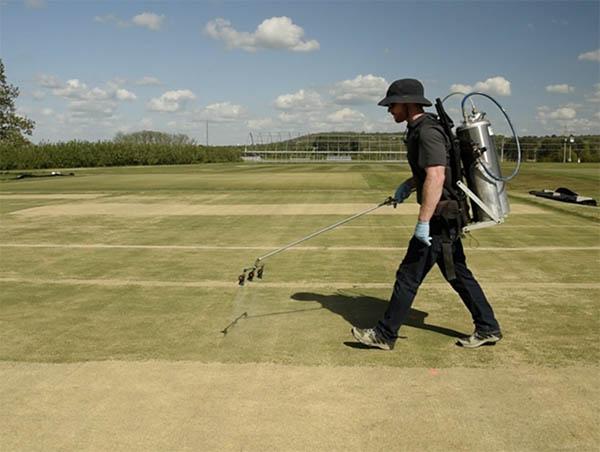Since Tifdwarf made it to market in 1965, ultradwarf Bermudagrasses have helped superintendents provide putting conditions that rival those historically associated with creeping bentgrass in areas where cool-season turf can struggle in searing summer heat.
 Conversely, those same warm-season turf types can suffer if exposed to prolonged winter conditions. Greens covers can provide relief from winter injury if used properly.
Conversely, those same warm-season turf types can suffer if exposed to prolonged winter conditions. Greens covers can provide relief from winter injury if used properly.Recent research conducted at the University of Arkansas helps establish thresholds for exposure of ultradwarf Bermudagrasses to cold temperatures, allowing superintendents to minimize the threat of winter damage and improving spring green up.
"This project was really focused around a lack of concrete evidence for the recommendation of covering (ultradwarf Bermudagrass greens) at 25 degrees," said Eric DeBoer, a master's student at Arkansas. "We wanted to come up with a concrete number backed by research that superintendents could make informed decisions around when covering their greens and hopefully help them save money by reducing covering events."
The research was funded by the USGA, Arkansas Turfgrass Association and the Arkansas GCSA.
The results of the trial, conducted in 2015-16 and 2016-17 at the University of Arkansas Agricultural Research and Experiment Station in Fayetteville, could be especially meaningful for superintendents managing warm-season turf in the transition zone, which typically experiences extreme heat in the summer and copious amounts of cold weather in the winter. While covering greens protects them from cold weather damage, it also prevents play and requires more manpower to deploy and remove, adding to the course's operating costs.
"The results will give superintendents better information on the low temperature threshold for applying the covers," said Mike Kenna, USGA research director. "This will help reduce the number of covering events, save labor costs, and increase days the golf course is open for play."
DeBoer and his research team that included advisor Mike Richardson, Ph.D., Doug Karcher, Ph.D., and program technician John McCalla, tested Champion, TifEagle and MiniVerde using covers at 25 degrees, 22 degrees, 18 degrees and 15 degrees Fahrenheit. TifEagle and MiniVerde proved to be more cold tolerant than Champion.
According to the study, Bermudagrass greens covered when temperatures reached 15 degrees survived throughout the winter with improved spring green up. Covered greens even survived two days of extreme cold temperatures where overnight lows dropped to 0 degrees on consecutive nights.
"We had two relatively mild years, but our second year we had two night get down to 0 degrees, and that was enough to kill our uncovered controls," said DeBoer, who interned at the Creek Club at Reynolds Lake Oconee in Georgia. "We haven't had any super long cold snaps or temps lower than that, but all plots covered, recovered similarly after being exposed to 0 (degrees) for two nights. Obviously, some things are out of our control, like overall low temps and the duration of the cold temperatures. I think the best thing to do is to let your ultradwarfs cold-acclimate through November and check into dormancy, because I think keeping them green through the fall into the winter, followed by a long cold snap could have negative effects."
The trial also included an untreated control. He used permeable covers and put down a late-season wetting agent application to control undetectable dry spots in dormant turf.
"So the idea behind a late-season wetting agent application is localized dry spot is apparent on actively growing turf but it may not be apparent on dormant turf like ultradwarfs," DeBoer. "This may be leading to increased winter injury from soil hydrophobicity throughout the winter.
"The wetting agent effect was most evident during the first year when, potentially due to natural causes, volumetric water contents were lower overall. This may benefit the plant by reducing desiccation but the increased water may also provide some extra insulation from low air temperatures.
"We presume this was due to higher volumetric water contents in the soil profile during the second year."
The trial will continue this year and next, and results should be ready for submission for peer review by next summer.

